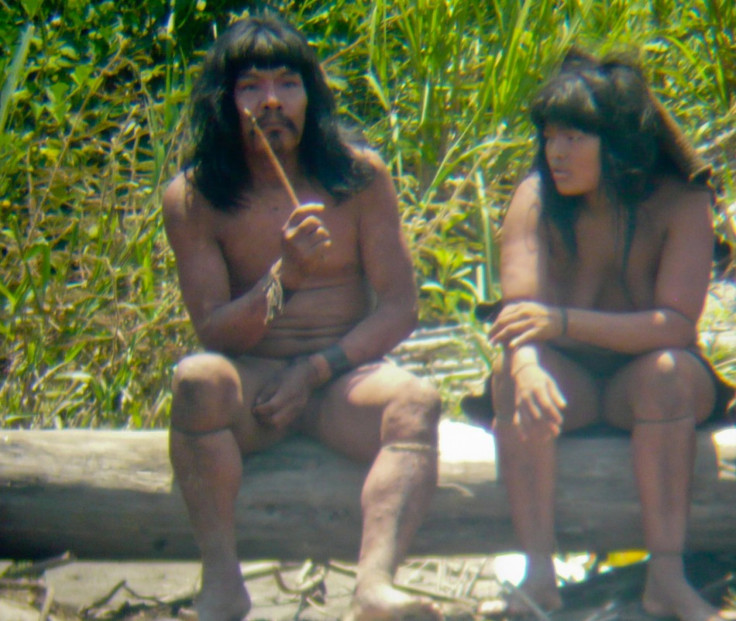Mashco Piro ‘Uncontacted’ Tribe: New Photos and Video Highlight Growing Tensions in Peru

Authorities in Peru are working to establish security in a remote corner of the Amazon following a recent spate of attacks by the isolated uncontacted tribe of Mashco Piro Indians.
The attacks, which occurred in October and November of last year, come amid an uptick in the number of sightings of the typically nomadic and elusive Mashco Piro along major waterways in the dense forests bordering Manú National Park. The issue poses an increasingly volatile situation for both settlers and tourists, but also the members of the isolated tribe.
On Tuesday, exactly one year after aerial photos from a nearby uncontacted tribe in the Brazilian Amazon astonished the world, tribal rights organization Survival International released new photos (above) of the Mashco Piro that it calls the clearest photos of an uncontacted tribe ever taken.
Mashco Piro have been known to inhabit the southeast Peruvian Amazon for many years and while a select few have made contact with the outside world, the majority have not. Studies have pointed to there being several Mashco Piro clans numbering roughly between 20-50 individuals in each group. They live in close proximity to about 14 or 15 other nomadic uncontacted tribes within the same region of the Peruvian Amazon and have long been considered among the Amazon's most implacable warriors, resisting contact and subjugation.
The Mashco Piro's forebears were decimated along the Madre de Dios River in 1892 by a private army employed by the notorious rubber baron Carlos Fermin Fitzcarraldo, vilified in Werner Herzog's 1982 classic Fitzcarraldo.
The images released Tuesday were taken by two photographers, Gabriella Galli and Diego Cortijo. Galli is an Italian Survival supporter who happened to be in the Manu region on a bird watching trip where she spotted the men on the riverbank from her boat. No contact was made.
Cortijo, meanwhile, is a Spanish archaeologist who was in the region in October on a research trip when the Mashco Piro group pictured turned up. He took the photographs from a distance of 400 feet with a camera attached to a telescope.
Survival believes the photos are of the same group of Mashco Piro that is thought to have launched a November attack.
Cortijo was staying with Matsigenka Indian Nicolás Shaco Flores, who witnesses say was struck in the heart by a bamboo-tipped arrow near the Manú National Park just one month later. He had been leaving food and gifts for a small group of Mashco Piro Indians for the last 20 years.
Shaco's death is a tragedy: he was a kind, courageous and knowledgeable man, Glenn Shepard, an anthropologist and friend of the victim, wrote in his blog and in Anthropology News. He believed he was helping the Mashco Piro. And yet in this tragic incident, the Mashco Piro have once again expressed their adamant desire to be left alone.
Rights activists described Flores as a go-between who had long played the role of intermediary between the nomadic tribe and the outside world. He had married a Piro woman and spoke enough of her language to make himself understood in conversations shouted at a distance from the Mashco Piro, according to Shepard.
Survival international believes illegal logging, low-flying helicopters, drug trafficking, and nearby oil and gas projects have caused the Mashco Piro to become more violent in recent years.
Prior to 2001, there were no reports of any violence amongst the Mashco Piro. It's only in recent years that they have begun to retaliate against colonists. They've also warned off tourists along the Manu River. A park guard was shot with an arrow in October around the same time that Peru's Ministry of the Environment released a sighting videotaped by tourists. The video (below) shows a tribe member warning the tourists off with a bow and arrow.
Tourism has become an increasing threat in recent months as the groups have appeared more frequently on the riverbanks, Survival spokesperson Rebecca Spooner told IBTimes. We were extremely concerned after we saw video footage of tourists leaving clothing to entice the Mashco Piro out of the forest as a kind of photo-op. All tourism on this particular stretch must be restricted until authorities can assure the safety of the Mashco Piro and the tourists, as well as local residents.
Survival wrote to Sernap (the park authorities in Peru) last year and was told that the organization planned to set up a guard post in the area and had imposed an inter-fluvial restriction on the river where the Indians were sighted.
This is still in place, Spooner said. However, there is still a real lack of control in the area to prevent the biggest dangers to the tribes, which are illegal loggers and nearby oil and gas companies who fly helicopters low over the area.
The tribal rights organization hopes by releasing the new images Tuesday, they can push the Peruvian government into action to protect the Mashco Piro who have clearly expressed their desire to be left alone.
© Copyright IBTimes 2024. All rights reserved.






















